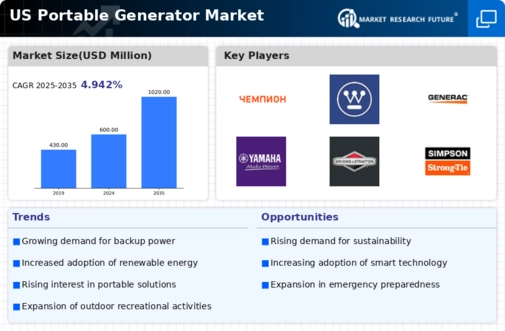Surge in Natural Disasters
The increasing frequency of natural disasters in the US has a profound impact on the portable generator market. Events such as hurricanes, wildfires, and floods have heightened awareness regarding the necessity of backup power solutions. According to the Federal Emergency Management Agency (FEMA), the number of declared disasters has risen by over 30% in the last decade. This trend suggests that consumers are more inclined to invest in portable generators to ensure power availability during emergencies. The portable generator market is likely to experience growth as households and businesses prioritize preparedness. Furthermore, the demand for reliable power sources during such crises may lead to innovations in generator technology, enhancing efficiency and user-friendliness.
Growth in Construction Activities
The robust growth in construction activities across the US is a significant driver for the portable generator market. As infrastructure projects expand, the need for reliable power sources on construction sites becomes paramount. The US Census Bureau reports that construction spending has increased by approximately 8% annually, indicating a strong demand for portable power solutions. Construction companies often require generators to operate tools and equipment, especially in remote locations without access to grid power. This trend suggests that the portable generator market will continue to thrive as contractors seek efficient and portable power solutions to meet their operational needs.
Increased Adoption of Renewable Energy
The rising adoption of renewable energy sources, such as solar and wind, is influencing the portable generator market. As more consumers and businesses invest in renewable energy systems, the need for backup power solutions becomes evident. Portable generators can complement renewable installations by providing power during periods of low energy production. The US Department of Energy indicates that renewable energy accounted for nearly 20% of total electricity generation in 2025, a figure that is expected to grow. This shift towards sustainable energy solutions may drive innovation within the portable generator market, leading to the development of hybrid models that integrate renewable technologies.
Technological Innovations in Generator Design
Technological innovations in generator design are reshaping the portable generator market. Advances in engine efficiency, noise reduction, and fuel consumption are making generators more appealing to consumers. The introduction of inverter generators, which provide cleaner power and are quieter than traditional models, has gained traction among users. The portable generator market is likely to benefit from these innovations, as consumers increasingly seek products that align with their lifestyle preferences. Additionally, features such as remote monitoring and smartphone connectivity are becoming more common, enhancing user experience and convenience. This trend indicates a shift towards more sophisticated and user-friendly portable generators.
Rising Consumer Awareness of Energy Independence
There is a growing consumer awareness regarding energy independence, which is driving the portable generator market. As individuals and businesses seek to reduce reliance on the grid, the demand for portable generators is likely to increase. This trend is particularly evident in areas prone to power outages, where consumers prioritize self-sufficiency. The portable generator market is experiencing a shift as more people recognize the value of having a backup power source readily available. Educational campaigns and community initiatives promoting energy independence further contribute to this trend, suggesting that the market will continue to expand as awareness grows.

























Leave a Comment